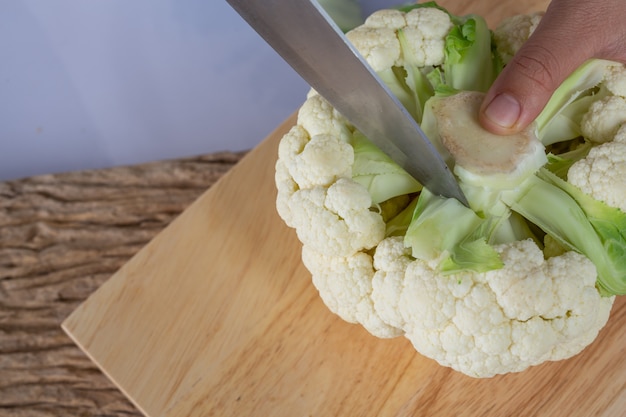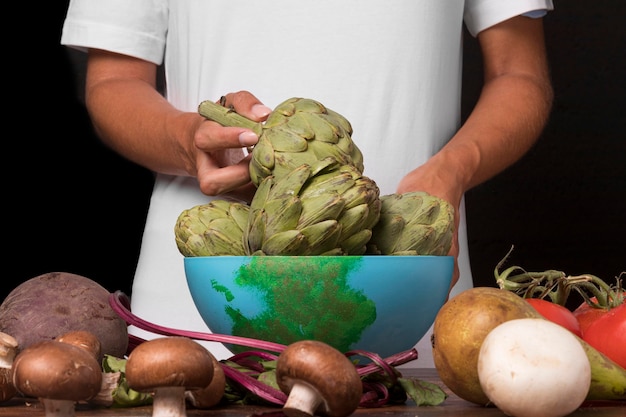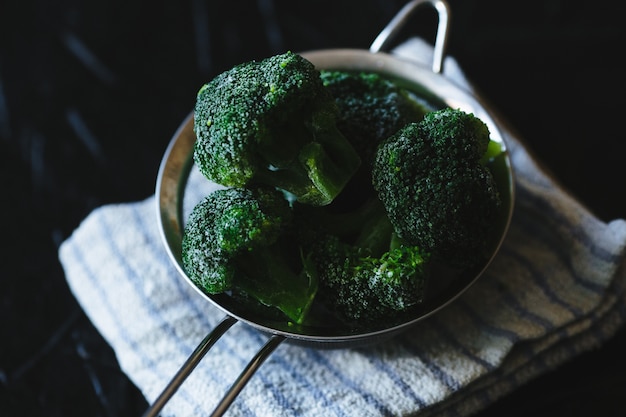Ah, broccoli. A trusty green companion in the kitchen, always ready to add a touch of healthy goodness to any meal. But how long do you cook it for? That's the million-dollar question, isn't it? Well, let's embark on a culinary adventure to discover the best ways to cook broccoli, from steaming to roasting and boiling, ensuring you always achieve that perfect, vibrant green, and flavourful result.
(Part 1) Steaming: A Gentle Path to Perfection

Steaming is my personal favourite method for cooking broccoli. It's a gentle approach that locks in nutrients, preserves its vibrant green hue, and avoids those soggy, overcooked nightmares. Plus, it's a healthy way to cook, as it requires no added oil or fat.
1. Getting Ready: The Broccoli Prep
First things first, we need to get our broccoli ready for its steamy bath. I start by trimming the tough ends, then break the florets into bite-sized pieces. No need to be overly precise – just aim for roughly the same size to ensure even cooking. And here's a little secret – don't discard the stalk! Cut it into smaller pieces, they're surprisingly delicious when cooked right. I know, I was sceptical too, but give it a go! You might just discover a new favourite part of the broccoli.
2. The Steaming Time: A Time for Tenderness
Now, the crucial bit – the steaming time. It all hinges on the size of your broccoli pieces. For those petite florets, think 3-4 minutes. For their larger counterparts, 5-6 minutes should do the trick. You're aiming for a bright green colour and a slight tenderness. Don't aim for mushiness, just that perfect balance of firmness and softness.
To test if it's ready, I usually give a floret a gentle poke with a fork. If it gives way easily, you're good to go. Of course, a timer is always handy, but trust me, the fork test is a reliable indicator!
I'll never forget the time my kids were little and we were having steamed broccoli. My youngest, bless her heart, was convinced the broccoli was still "alive." She'd poke it with a fork and ask, "Is it dead yet?" It's a question I've never been able to answer! I guess you just have to wait until it's soft enough to eat.
(Part 2) Roasting: Embracing Crispy Perfection

Roasting broccoli? It's the key to unlocking crispy, caramelised perfection. A touch of olive oil, a sprinkle of seasoning, and a good blast of heat in the oven, and you've got yourself a flavour explosion!
1. The Prep: A Touch of Oil and Spice
The prep for roasting is similar to steaming, but with a little extra TLC. I trim the ends and break the florets into medium-sized pieces. To add some extra flavour, I cut the stalk into thin slices, then give everything a good toss in olive oil and seasonings.
2. The Roast: A Dance with the Oven
Now, onto the roasting. Pop your prepped broccoli onto a baking sheet lined with parchment paper – this will make clean-up a breeze, I promise! I usually roast broccoli at 200°C (400°F) for about 20-25 minutes. You're aiming for that golden brown colour and slightly crispy texture. I often add some extra time for the stalk pieces, as they tend to be a bit denser.
Keep a close eye on it while it's roasting, as oven temperatures can vary, and you don't want it to burn. But don't worry, you'll know it's ready when it smells amazing and looks beautifully golden.
One time, I was roasting broccoli with garlic and a little balsamic vinegar. I totally forgot about it, and when I checked, it was a bit overdone. But you know what? It still tasted amazing. I just had to serve it with a big dollop of creamy mashed potatoes, and it was a hit! Sometimes, even overdone broccoli can be salvaged.
(Part 3) Boiling: The Classic Approach to Broccoli

Boiling broccoli might sound like the most basic approach, but it's a great go-to for quick and easy sides. It's also perfect for making broccoli soup or a creamy broccoli sauce.
1. The Prep: A Simple Start
The prep is the same as always: trim the ends and break the florets into medium-sized pieces. You can boil the stalk too, but it tends to be a bit tougher, so it might need a little extra cooking time.
2. The Boil: A Quick Dip in Hot Water
Fill a pot with water, bring it to a rolling boil, and then add your broccoli. Boil for 3-5 minutes, depending on the size of the pieces. You want it to be tender but still retain its bright green colour. You know it's done when the florets are easy to pierce with a fork.
Once it's cooked, drain it immediately, and run it under cold water. This will stop the cooking process and help keep the colour bright.
3. Adding a Touch of Flavour: Beyond the Basic Boil
For a more intense flavour, try adding a pinch of salt to the boiling water. This will season the broccoli and make it taste even better. If you're feeling adventurous, you could add a tablespoon of lemon juice to the water. It helps brighten the flavour and colour of the broccoli.
And remember, you can always use your boiled broccoli for other dishes, like broccoli salad, or blend it into a smooth, creamy soup.
(Part 4) Factors that Can Affect Broccoli Cooking Time
So, you've got your steaming, roasting, and boiling techniques down pat. But there are a few factors that can affect the cooking time, so it's good to be aware of them.
1. The Size of the Pieces: A Question of Scale
Obviously, bigger pieces take longer to cook. If you have some really large florets, you might need to add a few extra minutes to the cooking time.
2. The Freshness of the Broccoli: A Matter of Age
Fresh broccoli will cook more quickly than older broccoli. If your broccoli is starting to look a little limp, you might need to add a bit more time to the cooking process.
3. The Cooking Method: A Variety of Approaches
As we've discussed, different methods require different cooking times. Steaming is generally quicker than roasting, while boiling is usually the fastest method.
4. The Amount of Broccoli: A Matter of Quantity
If you're cooking a lot of broccoli, it will take longer than if you're only cooking a small amount. So, adjust your cooking time accordingly.
5. Altitude: A High-Flying Factor
I know this one might sound strange, but altitude can actually affect cooking time. Water boils at a lower temperature at higher altitudes, so you might need to add a bit more time to the cooking process.
(Part 5) Don't Be Afraid to Experiment! A Call for Creativity
It's important to remember that these are just guidelines. Every broccoli is different, every oven is different, every pan is different. So, don't be afraid to adjust the cooking time based on your own experience and preferences.
You can try different combinations of cooking methods and seasonings. Get creative! Add some garlic, ginger, chilli, lemon, or even a sprinkle of cheese. Broccoli is a versatile vegetable that can be enjoyed in so many different ways.
I find that a little trial and error goes a long way. Don't be afraid to experiment, and you'll soon find your perfect broccoli cooking time. You'll be a broccoli master in no time!
(Part 6) The Don'ts of Broccoli Cooking: Avoiding the Mistakes
So, we've covered the dos of broccoli cooking. But what about the don'ts? Let's tackle those.
1. Don't Overcook: A Quest for Tenderness, Not Mushiness
Overcooked broccoli becomes mushy and loses its flavour. The goal is to cook it until it's tender but still slightly firm. Don't let it become soggy!
2. Don't Overcrowd the Pan: A Space for Steam to Escape
When steaming or roasting, overcrowding the pan can make the broccoli steam rather than cook. If you've got a lot of broccoli, cook it in batches.
3. Don't Forget the Seasoning: Adding a Touch of Flavour
Don't be afraid to add some flavour to your broccoli. Salt, pepper, garlic, onion, herbs, or even a drizzle of olive oil can transform it from bland to delicious.
4. Don't Throw Away the Stalk: A Treasure Trove of Taste
I know some people don't like to eat broccoli stalks, but I say don't throw them away! Cut them into thin slices, add them to your dish, and you'll get a delicious and surprising burst of flavour.
(Part 7) Broccoli: A nutritional powerhouse: A Champion of Health
Let's talk about why we love broccoli so much: It's a nutritional powerhouse packed with vitamins, minerals, and antioxidants. It's a great source of vitamin C, vitamin K, folate, and fibre. It's also low in calories and fat, making it a healthy and satisfying addition to any meal.
So, not only is it delicious, but broccoli is good for you too! And that's why it deserves a spot on our plates, time and time again.
(Part 8) Broccoli Tips and Tricks: Mastering the Green Goodness
Let's dive into some useful tips and tricks for cooking and storing broccoli.
1. Storing Broccoli: Keeping it Fresh
To keep broccoli fresh for longer, store it in a plastic bag in the refrigerator for up to 5 days. If you need to store it for even longer, you can blanch it, then freeze it.
2. Blanching Broccoli: A Technique for Preservation
Blanching is a great way to preserve the colour and texture of broccoli. Simply boil it for 1-2 minutes, then plunge it into ice water. This will stop the cooking process and keep the broccoli bright green and firm.
3. Freezing Broccoli: A Stockpile of Green Goodness
Once you've blanched your broccoli, you can freeze it for up to 6 months. Simply drain it well, spread it out on a baking sheet, and freeze it until solid. Then, transfer it to an airtight container or freezer bag.
4. Reheating Broccoli: Bringing Back the Flavour
To reheat broccoli, you can steam it, roast it, or even microwave it. Just make sure it's heated through before serving.
(Part 9) broccoli recipes to Inspire You: Culinary Adventures with Broccoli
I know you're probably itching to try some of these broccoli cooking tips. So, here are a few recipe ideas to inspire you.
1. roasted broccoli with Garlic and Parmesan: A Classic with a Twist
This is a classic for a reason! Simply toss broccoli florets with olive oil, garlic, salt, pepper, and parmesan cheese. Roast at 200°C (400°F) for 20-25 minutes, until golden brown and crispy.
2. Broccoli and Cheddar Soup: Creamy Comfort in a Bowl
A creamy and comforting soup. Sauté some onion and garlic, then add broccoli florets and vegetable broth. Simmer until tender, then blend until smooth. Stir in some cheddar cheese and cream for a rich and flavorful soup.
3. Broccoli Salad: A Refreshing and Healthy Delight
A refreshing and healthy salad. Combine cooked broccoli with shredded carrots, celery, and your favorite dressing. You can add nuts, raisins, or even some crumbled bacon for extra flavour and texture.
(Part 10) FAQs: The Answers You Need
And finally, here are some frequently asked questions about broccoli cooking.
1. Can you overcook broccoli? A Question of Texture
Yes, you can overcook broccoli. Overcooked broccoli becomes mushy and loses its flavour. The goal is to cook it until it's tender but still slightly firm. Don't let it become soggy!
2. What is the best way to cook broccoli? A Matter of Preference
The best way to cook broccoli is subjective and depends on your personal preference. Steaming is a good option for retaining nutrients and a bright green colour, roasting yields crispy and caramelised broccoli, and boiling is a quick and easy method for a simple side dish.
3. How do I know when broccoli is done? The Fork Test
Broccoli is done when it is tender but still slightly firm. You can test it with a fork. If it easily pierces the florets without resistance, then it’s cooked.
4. What happens if you eat raw broccoli? A Question of Digestion
Raw broccoli is safe to eat, but it can be tough and difficult to digest. It’s best to cook broccoli to make it easier to chew and digest.
5. Can you freeze broccoli? A Stockpile of Green Goodness
Yes, you can freeze broccoli. Blanch it first to preserve its colour and texture, then spread it out on a baking sheet and freeze it until solid. Then, transfer it to an airtight container or freezer bag.
Everyone is watching

Perfect Rice Every Time: The Ultimate Guide to Cooking Rice
Cooking TipsAs a self-proclaimed foodie, I've always been a bit obsessed with rice. It's the foundation of countless cuisi...

Prime Rib Roast Cooking Time Chart: Per Pound Guide
Cooking TipsPrime rib roast. Just the name conjures images of lavish dinners, crackling fires, and hearty laughter. It’s ...

The Ultimate Guide to Cooking Asparagus: Tips, Techniques, and Recipes
Cooking TipsAsparagus. The mere mention of this spring delicacy conjures up images of vibrant green spears, crisp and burs...

Ultimate Guide to Cooking the Perfect Thanksgiving Turkey
Cooking TipsThanksgiving. Just the word conjures up images of overflowing tables laden with delicious food, the scent of r...

How Long to Bake Potatoes in the Oven (Perfect Every Time)
Cooking TipsBaked potatoes are a staple in my kitchen. They're incredibly versatile, delicious, and surprisingly easy to m...
